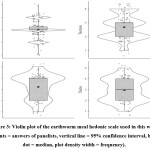Introduction
In recent decades, the rapid rise in the global human population has generated an increase in nutritional demand, mainly for protein but also for new food sources in general. These new sources should be sustainable and promote a diet that is varied, balanced, complete, sufficient, and innocuous. They should also be culturally and socially acceptable.1
Protein is an essential component of the human diet. Various studies have aimed to validate food alternatives that provide caloric energy, such as seaweed, flying fish eggs, insects, and earthworms.2,3,4 The Californian red worm, Eisenia foetida, of the family Lumbricidae, order Haplotaxides, and genus Eisenia, has also been proposed as a potential protein source. It has between 80 and 110 rings; exhibits a red, purple, or brown color; can be 23–130 millimeters in length; and weighs up to 1.5 g. Californian red worms play a significant role in soil health and could also be used as a human food source, as has been reported in some countries in Africa, Asia, and South America.5,6,7
The production of worms (vermicomposting) uses cattle manure (mainly from dairy cattle) as input or organic kitchen waste, thereby reducing waste and greenhouse gas emissions.1,7 Specimens obtained when harvesting earthworms are an excellent source of protein as they contain between 46 and 78% dry mass.1,3,6,7 Similarly, they provide readily available minerals required in the human diet, such as calcium, iron, zinc, phosphorus, potassium, magnesium, sodium, copper, manganese, and trace elements such as iodine and selenium.1,3,6,7,8 Furthermore, the consumption of earthworms can contribute significantly to the supply of essential amino acids (aspartic acid, serine, glutamic acid, proline, glycine alanine, valine, isoleucine, leucine, tyrosine, phenylalanine, histidine, lysine, arginine, cysteine, methionine, and threonine). Additionally, earthworms are a source of vitamins A, B1, B2, C, E, and fatty acids (omega-3, omega-6, octadecanoic acids, ω3 polysaturated lipids, lauric acid, tridecanoic acid, myristic acid, pentadecanoic acid, palmitic acid, oleic acid, erucic acid, linoleic acid, and linolenic acid) as well as fibrinolytic lumbrokinase enzymes.3,6,7
Previous studies have demonstrated the acceptability of earthworm meal when it is used in enriched corn-based arepas. This suggests that its use as an alternative nutritional source for humans may be highly viable.9,10 However, few works have verified the acceptability of consuming earthworm meal only as a condiment. Therefore, considering the nutritional value of earthworm meal, the present study was proposed to determine the protein content of an earthworm sample and to assess earthworm meal’s acceptability for human consumption. For this purpose, red Californian earthworms’ meal was prepared, its composition was analyzed and a sensory analysis was carried out.
Materials and Methods
Design, location, and time. This study adopted a cross-sectional quantitative approach at the explanatory–exploratory level. The protocol was approved by the Ethics Committee of the Universidad Vizcaya de las Américas. The participants, who were all of legal age, were informed about the study requirements and all signed an informed consent form. The study followed the guidelines of the Declaration of Helsinki (https://www.wma.net/policies-post/wma-declaration-of-helsinki-ethical-principles-for-medical-research-involving-human-subjects/), the National Bioethics Commission (Mexico), and article 100 of the General Health Law on Research for Health. Once the protocol was approved, the study was developed and initiated (Figure 1).
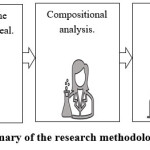 |
Figure 1: Summary of the research methodology of this study. |
Collecting red worms. Worms developed in compost (dairy bovine manure and pasture waste) were collected using the trapping method during the clitellate stage. The collected earthworms generally had diameters of 3 to 5 mm, weighed up to 1 g, and were 5 to 6 cm in length. They were purple-pink in color, had yellow on the tail, and had creamy white on the clitellum.
Preparing the earthworm meal. To obtain the earthworm meal, the worms were placed in a container. The compost waste and the residues surrounding the body were separated using tap water. Finally, they were rinsed with distilled water. Once clean, they were placed in a new container for sacrifice and immersed in water with NaCl (5%) for 10 min. The resulting solution was discarded and rinsed several times to remove excess salt, residue, and fluids excreted during death and, finally, the worms were rinsed with distilled water. Next, the worms were dried to remove excess water and were subsequently dehydrated by solar drying in the open air. They were then spread in a tray in a thin 0.5 cm thick layer for 72 h (average temperature of 35 ± 5°C). Finally, the dry biomass obtained was processed in a manual mill, screened (No. 35 mesh), homogenized, and stored in a hermetically sealed glass jar at room temperature (25 ± 5°C).
Compositional analysis. The earthworm meal was analyzed in the Laboratory of Food, Drugs, and Toxicology of the Faculty of Chemical Sciences of the Universidad Autónoma de Nuevo León (México), using an analytical method proposed by the American Association of Analytical Chemists (AOAC)11 that conforms to the Codex Alimentarius Commission and was certified by the institution.
Total ash. The earthworm meal sample, which had been dried in a muffle furnace at 550°C, was added and weighed in analytical balance at a constant weight and at room temperature. Then, the sample was slowly carbonized until it no longer emitted smoke, after which it was placed in a muffle furnace at 550°C for 6 h until whitish-greyish ashes were obtained. The crucible was removed and placed in an oven at 100°C for 20 min. Then, it was placed in a desiccator at room temperature until a constant weight was obtained. The total percentage of ash was calculated using Equation (Eq.) 1.12
Crude fiber. To determine crude fiber content, the residue from the extraction of the ethereal extract was placed in a digestion vessel, and 100 mL of boiling H2SO4 and 5 drops of isoamyl alcohol were added. This was immediately connected to a condenser and boiled for 30 min. Subsequently, the mixture was filtered through a filter cloth under a vacuum and washed with hot water. The filter cloth was dried with the residue and placed in Erlenmeyer glass, where it was washed with hot NaOH (0.313 N) and drops of isoamyl alcohol were added. Subsequently, it was boiled under reflux for 30 min. Next, it was filtered through a Büchner funnel using the same cloth. The residue was then dried and transferred to the crucible. Immediately, the crucible was dried to a constant weight in an oven at 110°C and then weighed (weight 1) and calcined in a muffle furnace at 600°C. Finally, it was placed in a desiccator and weighed (weight 2). The percentage of crude fiber was calculated using Eq. 2.11
Fat. 2 g of earthworm meal was added to a cellulose extraction thimble by adding sodium sulfate and sea sand. This was then mixed. The extraction thimble was placed in a beaker and dried for 6 h. The extraction thimble mixture was covered with absorbent cotton and placed in a Soxhlet extractor. In the lower part, the boiling flask was adjusted to a constant weight. Ether was added until obtain two unloading of the extractor. Then, the boiling flask was connected to a condenser on a hot grill. The extractor was withdrawn after 5 h and the ether was evaporated until the concentrated sample of fat was obtained. The boiling flask was placed in an oven at 100°C until it reached a constant weight. Finally, the boiling flask was cooled in a desiccator and weighed. The percentage of fat was calculated using Eq. 3.13
Moisture. 10 g of earthworm meal sample was added to a nickel capsule (weight 1). This was immediately heated to 100°C for 4 h. The capsule was removed and placed in a desiccator. Finally, the capsule was weighed (weight 2). Based on the differences in weight, the moisture percentage was determined using Eq. 4.14
Protein. 0.5 g of earthworm meal sample was weighed on wax paper. The sample was wrapped with wax paper and placed in a Kjeldahl flask. A digestion tablet (mixture of 1 g of copper sulfate and 5 g of potassium sulfate) was added. Subsequently, 10 mL of concentrated H2SO4 was carefully added. This was placed in a digester at 400°C. Once it gave off a blue-greenish-crystalline color, it was left to cool. A zinc shot, NaOH (50%), and deionized water were added. The reaction between the digested sample and H3BO3 (4% containing 5 drops of bromocresol green) was started in a distiller. Finally, the obtained distillate was titrated with valued HCl (0.1 N) until the sample turned from green to a reddish color. The protein content calculated using Eq 5. 6.25 was used as the nitrogen-to-protein conversion factor.15
Total carbohydrates. Finally, total carbohydrates were determined by difference using Eq. 6. They were all expressed as a percentage of dry mass.11
=(%crude protein+%crude ash + %ash) X 100
Sensory analysis. The earthworm meal was evaluated in a single meal by 120 non-expert male and female panelists between 18 and 60 years. Sensory analysis was conducted in a room at 25 ± 5°C under natural lighting inside the Universidad Vizcaya de las Américas campus Saltillo facilities. The earthworm meal sample (2 g) was placed in plastic containers. The panelists were asked to rate of the earthworm meal on four attributes: color, smell, taste, and texture using a five-point Likert-type hedonic scale: 1 (I love it), 2 (I like it), 3 (Indifferent), 4 (I don’t like it), and 5 (I hate it), assessing the level of liking by attribute (Table 1).
Table 1: Example of a Liker-type hedonic scale questionnaire applied to panelists.
| Characteristic | 1-I love it | 2-I like it | 3-Indifferent | 4-I don’t like it | 5-I hate it |
| Color | |||||
| Smell | |||||
| Texture | |||||
| Taste |
Statistical analysis
The data obtained from the proximal analysis and sensory analysis were analyzed descriptively, determining the mean, median, mode, minimum, and maximum as well as 95% confidence intervals (CI). In addition, Student’s t-test was applied. Spearman’s correlation analysis was also applied to the sensory evaluation data (120 replicates) to detect the relationship between earthworm meal attributes. This test was run at a significance level of p < 0.05 in the Jamovi 2.3.2.16 The results of the proximal analysis (expressed as the mean of three replicates) and the hedonic scale (obtained from 120 replicates) were represented using a radial graph. In contrast, the distribution of the hedonic scale was expressed using a violin graph to represent the distribution of data and its probability density, including its median, frequency, quartiles, 95% CI, minimum, and maximum.
Results
The average cost to produce 1 g of earthworm meal was around USD $0.24.
Proximal content
The earthworm meal used in the present study contained 6.69% total carbohydrates and 22.16% ashes. Likewise, a content of 2.23% crude fiber and about 5.22% fat was evidenced. In particular, the protein content found in the meal sample ranged from 51.63% (Figure 2).
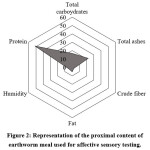 |
Figure 2: Representation of the proximal content of earthworm meal used for affective sensory testing. |
Evaluation of sensory analysis for affective acceptance tests.
The sensory test showed an attitude of 3.02 to the color of the earthworm meal (95% CI, 2.89–3.16), revealing a greater grouping to responses 3, 4, and 2 on the hedonic scale. In comparison, the texture was grouped around 2.68 (95% CI, 2.52–2.84), highlighting a greater likelihood of participants giving a response of 2. On the other hand, the smell was evaluated as 3.22 (95% CI, 3.02–3.42), with participants being most likely to rate it 4 on the scale. Finally, the taste had a mean of 2.95 (95% CI, 2.75–3.15), with 2 or 4 being the most likely responses (Figure 3).
Spearman’s test showed a significant correlation between taste and color (Rho = 0.181; p < 0.01), taste and texture (Rho = 0.327; p < 0.001), taste and smell (Rho = 0.343; p < 0.05), and smell and color (Rho = 0.267; p < 0.05) (Figure 4). This suggests that, statistically, the most relevant attribute of earthworm meal is its taste.
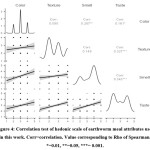 |
Figure 4: Correlation test of hedonic scale of earthworm meal attributes used in this work. Corr=correlation. Value corresponding to Rho of Spearman.*=0.01, **=0.05, ***= 0.001. |
Behavior of earthworm meal attributes
A distinctive brown color was obtained in the processed earthworm meal. 53.3% of panelists participating in the study were indifferent to this attribute. This was followed by 24.2% selecting I don’t like it and 20.0% selecting I like it. These responses suggests that the earthworm meal’s color is not a barrier to human consumption. Conversely, the earthworm meal’s texture (a sensory property detected by touch, sight, and hearing) was well received: 40% of panelists responded I like it and 31.7% of panelists responded that they were indifferent to the texture. Only 21.7% answered I don’t like it. Answers about taste were widely distributed: 34.2% of panelists expressed that they liked the taste of the earthworm meal, 30.8% didn’t like the taste, and 20.8% were indifferent. A slight majority of panelists did not like the smell of the earthworm meal; 45% answered I don’t like it, and 7.5% answered I hate it. However, 47.5% of panelists said they could accept this characteristic. Most of the panelists referred to a strong aroma that was very similar to the smell of dried fish (charales) or the smell of beef (Figure 5).
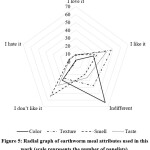 |
Figure 5: Radial graph of earthworm meal attributes used in this work (scale represents the number of panelists). |
Discussion
The characteristics of earthworm meal are strongly influenced by the type of feed given to the earthworms and the drying method. These factors further alter its nutritional composition and fatty acid profile.17,18 Compared to oven-drying, freeze-drying is a superior method of maintaining the characteristics of earthworms.18 However, the values found in the material used in this study are within the ranges reported by various studies.1,7,8 The fat content of the earthworm meal in this study was found to be as much as 65.6% lower than that of previous studies (p=0.006).3,6,7,18,19,20 However, the earthworm meal in this study had a higher ash content (p=0.001), compared to average of previous studies.1,3,6,19,20 Finally, the total carbohydrate content and humidity of the earthworm meal were found to be lower than that of previous studies (p=0.005 and p=0.000, respectively).1,7,18
The previous data suggests that the most suitable method for drying earthworms is likely lyophilization, followed by the sterilization process.1,18 Unfortunately, implementing these processes can considerably increase the cost of producing meal. Solar drying could be an initial alternative in the meal production process. Earthworm biomass is relatively cheap.20,21 However, it has been reported that smoked earthworms are sold at high prices in some Venezuelan markets.22 In this study, the cost per 1 g of earthworm meal was around USD $0.24, representing an economical advantage. It should be noted that costs will vary depending on the earthworm feed and the methodology used to obtain the meal.20
The protein content of the earthworm meal obtained in this study was relatively lower than has been reported by previous studies. Indeed, 21.35% less protein was found, compared to an average of previous studies (p=0.016).1,3,6,7,18,19,20,23 This discrepancy may be due to the temperature at which the meal was obtained, as protein denaturation may have occurred.18 Regardless, earthworm meal is classified as a protein-rich food and a high source of energy.6,20 It provides protein at values similar to that of eggs and has more than ground pork; it has only slightly less protein than chicken and salmon.3,24 This suggests that earthworm meal can be used as an ingredient in food preparation. Furthermore, the proteins in earthworm meal are highly water-soluble, helping people to meet their recommended daily protein intake.1,6,21 Earthworm meal can also be used to fortify the human diet by increasing protein intake.7,19
The significant relationship between taste and color, taste and texture, taste and smell, and smell and color suggest that, statistically, taste is the attribute of earthworm meal most relevant to its acceptability for human consumption. This can be explained by many people’s predisposed perceptions of earthworms, which they view as segmented and slimy animals.3 On the other hand, since the papillae perceive taste on the tongue and oral cavity, no taste memory allows the earthworm meal to be associated with a good taste. However, some participants related the taste to seafood and to the taste of small fish commonly known as charales (genus Chirostoma) that are endemic to Mexico. This significant correlation between the sensory parameters (Figure 4) may be due to the fact the aftertaste of the earthworm meal is consistent with its taste. Furthermore, taste is generally associated with the color and odor of food, which can hide its real taste.25,26
The data obtained suggest that color is not likely to restrict people’s consumption of earthworm meal. This is crucial to the acceptability of the product because people generally see the color of a product and make assumptions about its attractiveness and taste before they consume it.26,27 This indicates that panelists may have made an association between the color of the earthworm meal and a specific taste, partially explaining this correlation.26 Furthermore, the color of the meal is strongly linked to the feeding, slaughter, and processing of the earthworm, and it may have presented a light-yellow coloration.6 The same authors have reported that the taste of earthworm meal could be sweet. However, in this study, this was impossible to discern due to the slaughtering process used (5% NaCl solution) and the lack of trend in the taste. Some foods may have a natural correlation between color and taste; however, the earthworm meal production process affects this relationship, thereby improving color and taste.27
A slight majority of the panelists (52.5%) did not like the pungent aroma of the final product, which they compared to that of dried fish. They viewed it as an unpleasant odor that may make them unlikely to consume the product.1,3 The odor of earthworm meal is caused by the presence of chemical groups in the volatile fraction and its possible oxidation, which can produce ketones with undecan-2-ona, alcohols with pentan-1-ol, and aldehydes with hexanal.9 The same authors have found that partial delipidation can reduce the intensity of the odor of the meal, improving it organoleptically.1,9 This characteristic aroma similar to dried fish products25 may impact the acceptability of the product, as olfactory signals correlate with color and taste, thereby conditioning the perceived taste.26,27 These data suggest that alternatives should be developed that minimize, reduce, and hide the odor by mixing it with other foods or adding natural flavoring to promote its daily consumption. For example, one study used cocoa and cocoa/cinnamon to mask earthworm meal odor. Two batches of cookies were made and fortified with 3.9% and 5.2% earthworm protein, respectively.23 The same author reported good acceptability of the deodorized and fortified cookies with 5.6% earthworm protein.
The Mexican population’s attachment to a Western diet can make them resistant to accepting an unknown food.1 Nevertheless, based on the population’s protein needs and the relative acceptability of earthworm meal determined in this study, it could provide a large part of the dietary protein required by the population. Furthermore, it could satisfy the recommended nutritional demands of iron and selenium and also help to meet people’s iodine and zinc needs.1,3,21 The ideal amount for consumption will depend on the nutritional analysis for each batch of worm meal produced.
Although properly processed earthworms do not present a microbiological risk,19 it is important to note that this study establishes the protein content and the potential acceptance of earthworm’s meal consumption, moving forward, further studies are necessary to assess the toxicity and immune reactions that earthworms’ protein may cause in humans.19 Furthermore, the in vitro and in vivo digestibility of this protein source should be evaluated.
Conclusions
The earthworm meal consisted of 16.69% total carbohydrates, 22.16% total ashes, 2.23% crude fiber, 5.22% fat, and 51.63% protein. According to panelists, 45% answered that they did not like the smell. The texture was perceived more positively: 40% answered I like it. 34.2% I liked the taste, and attitudes to the color were in different (53.3%). The most significant relationships between sensory attributes were between taste and smell and taste and texture. As they have a high protein content and acceptability, earthworms could be an alternative food source in human nutrition. Earthworm meal production is low cost and helps to reduce the carbon footprint. However, it is necessary to develop focused sensory tests to determine earthworm meal’s potential viability in different population groups.
Acknowledgement
The author thanks the authorities of the Vizcaya Research, Development and Innovation Center as well as the Nutrition Coordination of the Universidad Vizcaya de las Américas (Saltillo campus) for the facilities for the development of this work.
Conflict of Interest
The Impact of COVID-19 Pandemic on Food and Nutrition Security and Dietary Habits among Syrian Refugees in Camps: A General Review
Funding sources
The author received no financial support for the research, authorship, and/or publication of this article.
References
- Tedesco D. E. A., Castrica M., Tava A., Panseri S., Balzaretti C. M. From a food safety prospective: The role of earthworms as food and feed in assuring food security and in valuing food waste. Insects, 2020;11(5):293. DOI: 3390/insects11050293
CrossRef - Kumar A., Mohanty V., Yashaswini P. Development of High Protein Nutrition Bar Enriched with Spirulina plantensis for Undernourished Children. Curr Res Nutr Food Sci. 2018;6(3):835-844. DOI: 12944/CRNFSJ.6.3.26
CrossRef - Ding S., Lin X., He S. Earthworms: A source of protein. J Food Sci Eng. 2019;9: 159-170.
CrossRef - Wahyudi V. A, Harini N., Manshur H. A., Wachid M., Aini A. N. Study of Protein Concentrate from Flying Fish Roe Filament and its Application for Nutrified Rice-Corn Milk. Curr Res Nutr Food Sci. 2022;10(2):766-776. DOI: 12944/CRNFSJ.10.2.29
CrossRef - Grdiša M., Gršić K., Grdiša M. D. Earthworms-role in soil fertility to the use in medicine and as a food. ISJ-Invert Surviv J.2013;10(1):38-45.
- Sun Z., Jiang H. Nutritive evaluation of earthworms as human food. In: Mikkola H. (Ed). Future Foods. London, England: IntechOpen; 2017:127-141. DOI: 10.5772/intechopen.70271
CrossRef - Gunya B., Masika P. J. Eisenia fetida worm as an alternative source of protein for poultry: a review. Int J Trop Insect Sci. 2021;42(1):1-8. DOI: 1007/s42690-021-00531-6
CrossRef - Yue S., Zhang H., Zhen H., Lin Z., Qiao Y. Selenium accumulation, speciation and bioaccessibility in selenium-enriched earthworm (Eisenia fetida). Microchem J. 2019;145:1-8.
CrossRef - Cayot N., Cayot P., Bou‐Maroun E., Laboure H., Abad‐Romero B., Pernin K., Seller-Alvarez N., Hernández A. V., Marquez E., Medina A. L. Physico‐chemical characterization of a non‐conventional food protein source from earthworms and sensory impact in arepas. Int J Food Sci Technol. 2009;44(11):2303-2313.
CrossRef - Abdel-Azeem A. A. F. Nutritional and health aspects of earthworms (Eisenia foetida) supplementation in poultry diets. EPSJ. 2022;42(1):39-57.
CrossRef - Association of Official Analytical Chemists, A.O.A.C. International. Method 962.09 Fiber crude in animal feed and pet food. Official Methods of Analysis, 17th ed.; Association of official analytical chemists, Inc., Maryland, USA; 2000; Volume 1.
- Secretaria de Salud. NMX-F-607-NORMEX. Determinación de cenizas en alimentos. Alimentos-Método de prueba. In Diario Oficial de la Federación; Dirección General de Normas: México City, México, 2013.
- Secretaria de Salud. NOM-086-SSA1. Alimentos y bebidas no alcohólicas con modificaciones en su composición: Bienes y servicios. Especificaciones nutrimentales. In Diario Oficial de la Federación; Dirección General de Normas: México City, México, 1994.
- Secretaria de Salud. NOM-116-SSA1. Determinación de humedad en alimentos por tratamiento térmico. Bienes y servicios método por arena o grava. In Diario Oficial de la Federación; Dirección General de Normas: México City, México, 1994.
- Secretaria de Salud. NMXF-608-NORMEX 2011. Determinación de proteína en alimentos. Métodos de Prueba. In Diario Oficial de la Federación; Dirección General de Normas: México City, México, 2011.
- The jamovi project. jamovi. (Version 1.6) [Computer Software]. 2021. Retrieved from https://www.jamovi.org
- García D. E., Cova L. J., Castro A. R., Medina M. G., Palma J. R. Efecto del sustrato alimenticio en la composición química y el valor nutritivo de la harina de la lombriz roja (Eisenia). Rev Cient-Fac Cien V.2009;19(1):55-62.
- Gunya B., Masika P. J., Hugo A., Muchenje V. Nutrient composition and fatty acid profiles of oven-dried and freeze-dried earthworm Eisenia foetida. J Food Nutrit Res.2016;4(6):343-348. DOI:12691/jfnr-4-6-1
- Medina A. L., Cova J. A., Vielma R. A., Pujic P., Carlos M. P., Torres J. V. Immunological and chemical analysis of proteins from Eisenia foetidaFood Agric Immunol. 2003;15(3-4):255-263.
CrossRef - Kostecka J., Garczyńska M., Pączka G., Mazur-Pączka A. Chemical Composition of Earthworm (Eisenia fetida) Biomass and Selected Determinants for its Production. J Ecol Eng. 2022;23(7):169-179. DOI: 10.12911/22998993/149940
CrossRef - Marcó L. M., Materano L., Verde D., Moreno J. A., Ríos Y., Torres G. Eficiencia de acumulación de Fe, Cu, Zn y Se en lombriz de tierra (Eisenia fetida) como base para la elaboración de un suplemento nutricional con oligoelementos. Avan Quim. 2012;7(1):35-41.
- Paoletti M. G., Buscardo E., VanderJagt, D. J., Pastuszyn A., Pizzoferrato L., Huang Y. S., Chuang L. T, Millson M., Cerda H., Torres F., Glew, R. H. Nutrient content of earthworms consumed by Ye’Kuana Amerindians of the Alto Orinoco of Venezuela. Proc R Soc Lond B Biol Sci. 2003;270:249-257. DOI 10.1098/rspb.2002.2141
CrossRef - Bou-Maroun E., Cartier C., Cabio’ch G., Lafarge C., Labouré H., Medina A. L., Cayot N. The potential use of raw and deodorized non-conventional protein powder in human food. In: Ferreira V., Lopez R. (Eds). Flavour Science: Proceedings from XIII Weurman Flavour Research Symposium. San Diego, EUA.: Academic Press; 2014:507-511. DOI: 10.1016/B978-0-12-398549-1.00094-5
CrossRef - Zhenjun S., Xianchun L., Lihui S., Chunyang S. Earthworm as a potential protein resource. Ecol Food Nutr. 1997;36(2-4):221-236.
CrossRef - Gedrovica I. Assessment of Earthworm (Lumbricidae) Species Suitability for Processing into Powder. Am J Entomol. 2020;4(3):45-50.
CrossRef - Spence C., Levitan C. A. Exploring the links between colours and tastes/flavours. J Percept Imaging. 2022;R5:000408-1–000408-16. DOI: 2352/J.Percept.Imaging.2022.5.000408
CrossRef - Spence C. On the relationship (s) between color and taste/flavor. Exp Psychol. 2019;66:99-111. DOI: 10.1027/1618-3169/a000439
CrossRef

This work is licensed under a Creative Commons Attribution 4.0 International License.






